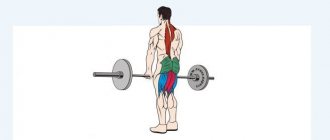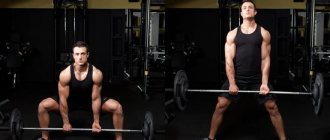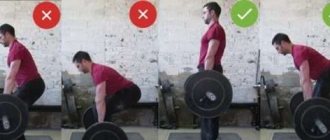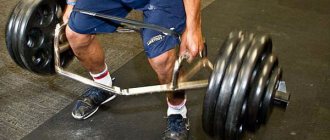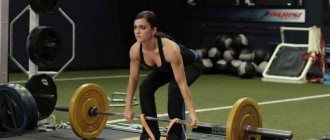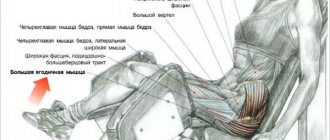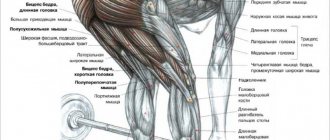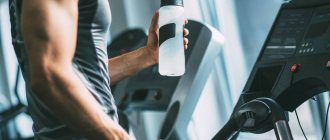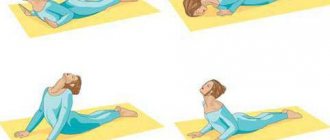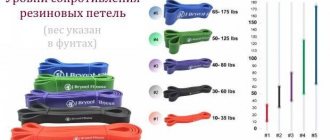Neuromuscular efficiency
Neuromuscular efficiency
- in a broad sense, this concept leads us to understand the combination of mental processes and muscle strength. Any muscle contraction begins in the brain. The part in your head called the "motor center" sends an electrical signal up the spine and down the motor nerves into the muscle fibers, causing them to contract. Sports training leads to changes in the system that enable muscles to contract faster, using more force and more efficiently. If you imagine your brain as a drill sergeant ordering a platoon of muscle fibers to begin contracting, for you this view may have the same effect as increasing the volume of commands from a whisper to a shout.
The development of neuromuscular activity occurs independently of muscle growth. This is why you can never tell for sure how strong someone is based on the size of their muscles. A person with relatively small muscles and a high level of neuromuscular activity is more likely to be able to defeat a person with large muscles and a low level of neuromuscular activity.
Ideally, training to increase muscle cross-sectional area is different from training to increase neuromuscular activity. If you are a beginner, then most likely you will not notice this difference and any type of training will help you both increase muscle size and increase neuromuscular activity. By increasing the number of exercises or the weight of the barbell, you will continue to develop the cross-sectional area of your muscles, as well as increase neuromuscular activity. Although, as you become more experienced, you will come to the conclusion that it is simply impossible to find a type of training that would increase muscle size and strength at the same time. In fact, you cannot increase the number of exercises and the weight of the barbell at the same time. If you want to increase the volume of your workouts, you will inevitably have to limit the amount of weight you lift so your muscles don't become exhausted very quickly. But if you decide to increase the weight you lift, then you will need to limit your training volume because lifting (working) very heavy weights will fatigue your muscles.
Lifting very heavy loads is the most effective way to increase neuromuscular activity. Therefore, if you choose to increase the number of exercises rather than the weights with which you perform them, you will most likely end up in a state where the amount of exercise you do to increase the size of your muscles is done at the expense of your neuromuscular activity , and muscle strength stops developing altogether. However, if your goal is to increase maximal muscle strength as much as possible, then you need to train in a way that balances muscle growth and development of neuromuscular activity.
Read more:
Differences between training for strength and mass
Tendon thickness
A very important factor. The fact is that the body, with the growth of certain parameters, when it comes across a weak link, stops the growth of these parameters. In our case, this means that muscle strength will not increase more than the tendon can support. If, under the influence of some psychotropic substances, the muscles are forced to contract more strongly, the tendon will simply tear off the bone. Therefore, the body unconsciously inhibits the growth of muscle strength if this strength approaches the strength of the tendons.
Is it possible to influence this factor? Partly. In many ways, the thickness of tendons is determined genetically and in childhood. When you are already an adult, you can strengthen your tendons through training, but only slightly.
Assessment of maximum, maximum voluntary, absolute and relative muscle strength
Source:
Textbook for Universities “Sports Physiology”. Author
: I.I.
Zemtsova Ed.
: Olympic literature, 2010.
Force
- this is the ability of muscles to overcome external resistance or counteract it through muscle effort. It manifests itself in the following basic forms: maximum muscle strength (absolute and relative), speed (dynamic), static (isometric) strength and strength endurance (Aganyants, 2001; Ostapenko, 2002; Sports Physiology, 1986).
Under maximum force
imply the greatest ability that an athlete is able to demonstrate with maximum voluntary muscle contraction.
The maximum strength of a muscle depends on the number and thickness of its muscle fibers. The number and thickness of muscle fibers determine the thickness of the muscle as a whole - anatomical diameter
, that is,
cross-sectional
.
The ratio of the maximum muscle strength to its anatomical diameter is called relative muscle strength
.
The cross section of a muscle perpendicular to the direction of its fibers constitutes its physiological diameter
. For muscles with parallel fiber directions, the physiological diameter coincides with the anatomical one. The ratio of the maximum strength of a muscle to its physiological diameter is called the absolute strength of the muscle.
Speed Force
(explosive) is the ability to exert the greatest force in the shortest time.
Strength endurance
is the ability of a muscle or muscle group to resist fatigue during repeated muscle contractions.
For the development of strength, there are certain age periods when morphological and functional prerequisites are favorable: girls are 9-11 years old, and boys have two periods - 9-12 years and 14-17 years (Apanasenko, 1985; Viksne, 1989; Ermolaev , 2001; Fomin, Vavilov, 1991).
A distinction is made between maximum static and maximum dynamic force. Maximum static force
manifests itself during isometric muscle contraction. The conditions for the manifestation of maximum static force are as follows:
- activation of all motor units;
- muscle contraction under conditions of complete tetanus;
- muscle contraction at rest;
- mobilization of the activity of the sympathetic nervous system, etc.
Maximum dynamic force
- this is the force exerted by an athlete during maximum voluntary muscle contraction without taking into account time and body weight. Explosive force is provided mainly by:
- frequency of impulses at the beginning of contraction and synchronization of impulses of various motor neurons (intramuscular coordination);
- contractile properties of muscles (intramuscular coordination);
- degree of hypertrophy of fast-twitch muscle fibers, etc.
Strength training sessions stimulate sarcoplasmic and myofibrillar hypertrophy (increased muscle girth) (Sports Pharmacology, 1986; Solodkov, Sologub, 2003). Sarcoplasmic hypertrophy
is caused by an increase in the volume of sarcoplasm, the content of mitochondrial proteins, metabolic reserves, myoglobin, and the number of capillaries. Slow muscle fibers are most prone to such transformations, and fast muscle fibers are oxidized. This type of hypertrophy has little effect on strength gains, but increases the ability to work for a long time (endurance).
Myofibrillar hypertrophy
is caused by an increase in the volume of myofibrils due to actomyosin. At the same time, strength increases significantly. Androgens and adrenal hormones, as well as drugs with anabolic effects, play a major role in activating the synthesis of protein and nucleic acids. In all cases, these two types of hypertrophy develop with the predominant development of one of them.
Ratio of fast and slow fibers
I think many people know that we have so-called fast (white) and slow (red) muscle fibers. This should not be taken literally. The differences between them are very arbitrary. It’s just that red fibers, due to the fact that they have more mitochondria and better blood supply, are more suitable for working not on strength, but on endurance. Fast fibers (white) are more suitable for explosive short-term work. The ratio of these fibers is different for different muscle groups. Therefore, some muscles (for example, the lower leg) are famous for their endurance, while others (the chest) are famous for their strength. Also, with age, the number of fast fibers decreases, and slow fibers increase. There is simply a transformation of some fibers into others.
Is it possible to somehow influence this factor? No you can not. The ratio of certain fibers is determined genetically. That is why some are better suited from birth for strength sports, while others are better suited for aerobic sports. You can only purposefully train one or another type of fiber with the help of training. And even then, this is also conditional.
Testing
Equipment
: wrist and backbone dynamometers.
- Maximum muscle strength
is assessed using different dynamometers. A hand dynamometer (Collin dynamometer) is used to measure muscle strength in the forearm and hand. A backbone dynamometer is used to record the strength of the trunk extensor muscles.
All subjects measure the strength of the forearm and hand muscles, as well as the strength of the extensor muscles of the trunk, two to three times and record the best result. It should be remembered that deadlift strength is not tested in the case of lower back pain, damage to the abdominal muscles, back muscles; in women - during menstruation and pregnancy.
- Determination of speed strength
in subjects is carried out using the following exercises:
- assessment of leg muscle strength: standing long jump, standing jump, number of squats in 20 s, number of jumps on the right (left) leg in 10 s;
- assessment of arm muscle strength: flexion and extension of arms while lying down for 10 s (number of times), number of pull-ups on the bar for 10 s;
- assessment of the strength of the abdominal and back muscles: bending the back from a position lying on the stomach for 10 s (number of times), raising the body from a position lying on the back to a straight squat (number of times in 10 s), while hanging, raising the legs forward (number of times per 10 s).
- An assessment of the strength endurance
of the muscles of the arms and the waist of the upper limbs of the subjects can be carried out while performing pull-ups on the crossbar or flexion and extension of the arms in support on the uneven bars. For the abdominal muscles, lifting and lowering the torso from a supine position is used, and for the leg muscles, squats are used.
The data obtained is entered into table 27, compared and conclusions are drawn about the strength capabilities of all subjects.
Table 27 — Determination of power capabilities
| Subject | Maximum muscle strength | Speed muscle strength | Strength endurance |
Results of More Recent Deadlift Studies
In 2000-2002, Escamila et al presented a three-dimensional biomechanical analysis of the traditional floor deadlift and the sumo (legs wide apart) deadlift. In particular, they noted that three-dimensional analysis more accurately creates an idea of the angles and joint moments of the lower extremities when performing deadlifts. Compared with the 2D studies, the 3D motion analysis showed significantly different joint angles: the shank-to-thigh and thigh-torso angles were smaller, while the hip flexion angle was greater. The researchers emphasized that when assessing movement occurring in the sagittal plane, such as the torso, two-dimensional analysis is quite acceptable.
Among 110 powerlifters at the US National Championships, 70% used traditional floor deadlifts. At the same time, in the heavy weight categories (90-125+ kg), 85% of the athletes pulled in the traditional style, while among 56 athletes in the lighter categories (52-82 kg), only 55% used the traditional deadlift style. When normalizing growth rates, in the traditional style of deadlift, the bar and GCM move more by 20-25%, since the width of the rack in the sumo style is 2-3 times larger (traditional - 32 ± 8 cm; sumo 70 ± 11 cm). The grip width was 47 ± 4 cm in the sumo deadlift and 55 ± 10 cm in the traditional deadlift. The bar lifted an average of 0.44 m in the traditional style and 0.35 m in the sumo style. Accordingly, this leads to a reduction in mechanical work by 25-30%. It is noteworthy that with the traditional deadlift style, the main work is performed by the foot flexors, knee and hip extensors: glutes, hamstrings, quadriceps and triceps surae. Whereas in sumo style, the muscles that control or produce the movement are the extensors of the foot, knee and hip: the gluteal muscles, the hamstrings, the quadriceps femoris and the tibialis anterior. Relatively large moments were observed in the ankle and knee joints during sumo deadlifts. In a traditional deadlift, there is relatively more activity in the hamstrings, while in a sumo deadlift, there is relatively more activity in the quadriceps. It should be noted that measurement of EMG activity of the calf muscles confirmed differences in activation between muscles, but the differences were relatively small.
In a study by S^leshkI et al. it is shown that, compared to traditional deadlifts, with the sumo style there is a more vertical position of the torso, which leads to a 10% decrease in the moment in MD5 and an 8% decrease in the shear force of L4/L5. This means a reduced risk of lower back injury from sumo deadlifts. However, traditional deadlifts are probably more effective for developing back and hamstring muscles. To test this hypothesis, a study of EMG muscle activity was conducted during traditional and sumo-style floor deadlifts with and without a belt. The experiment compared the activity of 16 muscles:
- thighs: rectus, vastus lateralis and medialis, lateral and medial muscles of the posterior thigh, adductors, gluteus maximus;
- lower leg: lateral and medial gastrocnemius, anterior tibial;
- back: thoracic and lumbar paravertebral, middle and upper trapezoid;
- abdomen: external oblique, straight.
See also: Exercise bike at home
Thirteen American football players performed both versions of the deadlift with and without a belt, 4 repetitions each with a weight of 12 RM at a regular tempo of 2.50-2.75 s.
EMG activity analysis data showed that the sumo deadlift activates the vastus medialis and vastus lateralis muscles, as well as the tibialis anterior muscle to a greater extent, but significantly less the medial gastrocnemius muscle. Performing belt rows resulted in significantly greater rectus abdominis activity but significantly less external oblique activity. There were no differences between the activity of other muscles.
When performing deadlifts from the floor, muscle activity changed in individual phases of the lift. The quadriceps femoris, tibialis anterior, adductor, gluteus maximus, paravertebral, and middle trapezius muscles were significantly more active in the knee flexion range of 61-90° compared to the 0-30° range (where 0° is an extended knee). However, the hamstrings, calves and upper trapezius muscles were most active in the 0-30° range.
According to the results of the study by Escamila et al. The sumo deadlift is performed with a more upright torso position and a wider stance than a traditional floor deadlift. The sumo style is more effective for developing the foot and knee extensors, while the traditional deadlift is perhaps more effective for developing the foot and knee flexors. As powerlifters become more skilled, their lifting mechanics improve, in particular, the bar is held closer to the body, which has a positive effect on the performance of the movement and reduces the risk of injury.
In the work of Swinton et al. compared the performance of a traditional deadlift from the floor with a regular and an ar-bar (hexagonal shape). The study involved 19 powerlifters with 13.7 ± 5.2 years of training experience. The hexagonal bar made it possible to lift more weight 265 ± 41 kg and develop greater force power of 4872 ± 636 W, compared to the conventional barbell 245 ± 39 kg and 4388 ± 713, respectively (p < 0.05). The use of a hexagonal bar has a significant effect on movement: peak moments in the lumbar spine, hip and ankle joints decrease (p<0.05), while peak moments in the knee joints increase (p<0.05). The load on the lower back has decreased due to a decrease in:
See also: SECOND STAGE OF CLASSES
a) horizontal displacement (by 75%) during lifting,
b) the angle of flexion of the hip joints at the start,
c) the distance between the center of the ankle joint and the weight.
The load on the thigh muscles, on the contrary, increases due to a greater angle of flexion of the knee joint. I will note another advantage of the hexagonal bar - a more physiological grip, which makes it easier not only to hold the barbell, but also helps to maintain a neutral position of the back and shoulder blades.
To conclude our discussion of the floor deadlift, here are the results of a study that assessed the effect of decreased stability of the support surface on muscle activity and the ability to develop force. In an experiment by Chulvi-Medrano et al. compared the activity of the lumbar, thoracic multifidus, and erector spinae muscles during deadlifts on a stable surface and on unstable surfaces (Bosu and T-Bosch). Trained students of a physical education university took part in the experiment (n=31). The loading protocol included deadlifting on an unstable surface with a load of 70% RM, first static (5 s tension), then dynamic (6 repetitions, 2 s lowering and 2 s pulling) on three different surfaces. Preliminarily, PM and MPIS were assessed for stable and unstable surfaces.
Maximum isometric force decreased with increasing instability level: by 8.80% T-Bow and by 34.19% Bosu. Based on these results, the authors do not recommend using unstable surfaces to train the deep back muscles. When using an unstable surface, it is preferable to use instability in one plane.
Authors: Jim Stoppani, Dmitry Sillov
Similar articles
- Muscle work when performing deadlifts
- Research results
- Work of muscle groups during leg presses
Psycho-emotional arousal
Well, I think everything is clear here. Let's take a person and ask him to push the maximum weight that he can. And then we’ll take the same person, put a gun to his head and say that if he doesn’t now bench press 10 kg more than he just bench pressed, we’ll shoot him. And, lo and behold! Strength increases! ))
Everything is quite simple here. Muscles contract with a force directly proportional to the strength of the signal from the brain that reaches them via motor neurons. The stronger the signal, the stronger the contraction. And the more excited you are, the stronger the signal the brain is able to send. This is why athletes (especially lifters) beat themselves and scream before going on the platform. Personally, I did the same at the beginning of my sports career. But then I realized that aerobatics is when you go onto the platform absolutely calm and at the same time show the maximum result. This probably comes with age.
https://youtu.be/vgJLRRpRq-g
